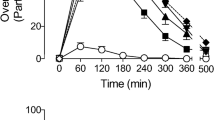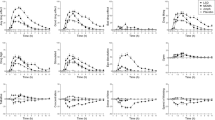Abstract
Meperidine is a mu opiate agonist that is frequently used to treat pain. We examined in healthy volunteers (N=10) the effects of intravenous meperidine (0, 0.25, 0.5, and 1.0 mg/kg) on mood and psychomotor performance. A randomized, placebo-controlled, crossover design was used in which subjects were injected with meperidine or saline in a double-blind fashion. Subjects completed several subjective effects questionnaires commonly used in abuse liability testing studies before drug injection and at periodic intervals for up to 5 h after drug injection. Subjects also completed several psychomotor tests. Meperidine produced a constellation of subjective effects in a dose-related fashion, including increases in ratings of “sedated,” “coasting or spaced out” and “feel drug effect” ratings. Many of the drug's subjective effects persisted up to 4 or 5 h after administration of the 1.0 mg/kg dose. Drug liking ratings assessed on a visual analog scale were increased after meperidine injection in about half of the subjects (P=0.09). Eye-hand coordination was affected slightly by meperidine but other indices of psychomotor functioning were unaffected. Miosis increased in a dose-related fashion. Other physiological parameters, such as vital signs, were not affected by meperidine. We conclude that meperidine in healthy volunteers has robust and long-lasting effects on mood, but may have weaker effects on psychomotor performance.
Similar content being viewed by others
References
American Psychiatric Association (1987) Diagnostic and statistical manual of mental disorders. American Psychiatric Association, Washington DC
Batterman RC (1943) Clinical effectiveness and safety of a new synthetic analgesic drug, demerol. Arch Int Med 71:345–356
Bigelow GE, Griffiths RR, Liebson IA, Kalisazak JE (1980) Double-blind evaluation of reinforcing and anorectic actions of weight control medications. Arch Gen Psychiatry 37:1018–1023
Derogatis LR, Lipman RS, Cozi L (1973) HSCL-90: an outpatient psychiatric rating scale — a preliminary report. Psychopharmacol Bull 9:13–17
de Wit H, Uhlenhuth EH, Johanson CE (1987) Individual difference in behavioral and subjective responses to alcohol. Alcohol Clin Exp Res 11:52–59
de Wit H, Pierri J, Johanson CE (1989a) Assessing pentobarbital preference in normal volunteers using a cumulative dosing procedure. Psychopharmacology 99:416–421
de Wit H, Pierri J, Johanson CE (1989b) Reinforcing and subjective effects of diazepam in nondrug-abusing volunteers. Pharmacol Biochem Behav 33:205–213
Dohrn CS, Lichtor JL, Finn RS, Coalson DW, Uitvlugt A, deWit H, Zacny JP (1992) Subjective and psychomotor effects of nitrous oxide in normal volunteers. Behav Pharmacol 3:19–30
Fraser HF, van Horn GD, Wolbach AB, Isbell H (1961) Methods for evaluating addiction liability. (A) “Attitude” of opiate addicts toward opiate-like drugs, (B) A short-term “direct” addiction test. J Pharmacol Exp Ther 133:371–387
Ghoneim MM, Dhanaraj J, Choi WW (1984) Comparison of four opioid analgesics as supplements to nitrous oxide anesthesia. Anesth Analg 63:405–412
Gravenstein JS, Smith GM, Sphire R, Isaacs JP, Beecher HK (1956) Dihydocodeine: Further development in measurement of analgesic power and appraisal of psychologic side effects of analgesic agents. New Engl J Med 254:877–885
Haertzen CA (1966) Development of scales based on patterns of drug effects, using the Addition Research Center Inventory (ARCI). Psychol Rep 18:163–194
Hannington-Kiff JG (1970) Measurement of recovery from outpatient general anaesthesia with a simple ocular test. BMJ 3:132–135
Hindmarch I (1980) Psychomotor function and psychoactive drugs. Br J Clin Pharmacol 10:189–209
Hoehe M, Duka T, Doenicke A (1988) Human studies on the μ opiate receptor agonist fentanyl: neuroendocrine and behavioral responses. Psychoneuroendocrinology 13:397–408
Jaffe J, Martin WR (1990) Opioid analgesics and antagonists. In: Gilman AG, Rall TW, Nies AS, Taylor P (eds) Goodman and Gilman's The pharmacological basis of therapeutics. Pergamon Press, New York, pp 485–521
Jarvik LF, Simpson JH, Guthrie D, Liston EH (1981) Morphine, experimental pain, and psychological reactions. Psychopharmacology 75:124–131
Jasinski DR, Preston KL (1986) Evaluation of tilidine for morphine-like subjective effects and euphoria. Drug Alcohol Depend 18:273–292
Johanson CE, de Wit H (1989) The use of choice procedures for assessing the reinforcing properties of drugs in humans. In: Fischman MW, Mello NK (eds) Testing for abuse liability of drugs in humans. NIDA Research Monograph #92, pp 171–210, US-DHHS (ADM) 89-1613, Rockville, MD
Kornetsky C, Humphries O, Evarts EV (1957) Comparison of psychological effects of certain centrally acting drugs in man. Arch Neurol Psychiatry 77:318–324
Korttila K, Linnoila M (1975) Psychomotor skills related to driving after intramuscular administration of diazepam and meperidine. Anesthesiology 42:685–691
Korttila K, Nuotto EJ, Lichtor JL, Ostman PL, Apfelbaum J, Rupani G (1992) Clinical recovery and psychomotor function after brief anesthesia with propofol or thiopental. Anesthesiology 76:676–681
Lamb RJ, Preston KL, Schindler CW, Meisch RA, Davis F, Katz JL, Henningfield JE, Goldberg SR (1991) The reinforcing and subjective effects of morphine in post-addicts: a dose-response study. J Pharmacol Exp Ther 259:1165–1173
Lasagna L, von Felsinger JM, Beecher JK (1955) Drug-induced mood changes in man. JAMA 157:1006–1020
MacAuliffe WE (1975) A second look at first effects: the subjective effects of opiates on nonaddicts. J Drug Issues 5:369–399
Manner T, Kanto J, Salonen M (1987) Simple devices in differentiating the effects of buprenorphine and fentanyl in healthy volunteers. Eur J Clin Pharmacol 31:673–676
Martin WR, Sloan JW, Sapira JD, Jasinski DR (1971) Physiologic, subjective, and behavioral effects of amphetamine, methamphetamine, ephedrine, phenmetrazine, and methylphenidate in man. Clin Pharmacol Ther 12:245–258
Matejcek M, Pokorny R, Ferber G, Klee H (1988) Effect of morphine on the electroencephalogram and other physiological and behavioral parameters. Neuropsychobiology 19:202–211
Nuotto EJ, Korttila KT (1991) Evaluation of a new computerized psychomotor test battery: effects of alcohol. Pharmacol Toxicol 68:360–365
Nuotto EJ, Korttila KT, Lichtor JL, Ostman PL, Rupani G (1992) Sedation and recovery of psychomotor function after intravenous administration of various doses of midazolam and diazepam. Anesth Analg 74:265–271
Overton DA, Batta SK (1979) Investigation of narcotics and antitussives using drug discrimination techniques. J Pharmacol Exp Ther 211:401–408
Pandit SK, Kothary SP (1989) Intravenous narcotics for premedication in outpatient anaesthesia. Acta Anaesthesiol Scand 33:353–358
Parrott AC (1986) The effects of transdermal scoplamine and four dose levels of oral scopolamine and four dose levels of oral scoplamine (0.15, 0.3, 0.6, and 1.2 mg) upon psychological performance. Psychopharmacology 89:347–354
Penetar DM, Henningfield JE (1986) Psychoactivity of atropine in normal volunteers. Pharmacol Biochem Behav 24:1111–1113
Porter J, Jick H (1980) Addiction is rare in inpatients treated with narcotics. New Engl J Med 302:123
Posner J, Telekes A, Crowley D, Phillipson R, Peck AW (1985) Effects of an opiate on cold-induced pain and the CNS in healthy volunteers. Pain 23:73–82
Preston KL, Jasinski DR (1991) Abuse liability studies of opioid agonist-antagonists in humans. Drug Alcohol Depend 28:49–82
Preston KL, Bigelow GE, Liebson IA (1989) Antagonist effects of nalbuphine in opioid-dependent human volunteers. J Pharmacol Exp Ther 248:929–937
Romagnoli A, Keats AS (1984) Ceiling respiratory depression by dezocine. Clin Pharmacol Ther 35:367–373
Saarialho-Kere U, Mattila MJ, Seppala T (1989) Psychomotor, respiratory and neuroendocrinological effects of a μ-opioid receptor agonist (oxycodone) in healthy volunteers. Pharmacol Toxicol 65:252–257
Sannita WG, Maggi L, Rosadini G (1987) Effects of scopolamine (0.25–0.75 mg i.v.) on the quantitative EEG and the neuropsychological status of healthy volunteers. Neuropsychobiology 17:199–205
Sbriglio R, Hartmen N, Millman RB, Khuri ET (1988) Drug and alcohol abuse in children and adolescents. In: Kesterbaum CJ, Williams DT (eds) Handbook of clinical assessment of children and adolescents, Vol II. University Press, New York
Schaeffer GJ, Holtzman SG (1977) Discriminative effects of morphine in the squirrel monkey. J Pharmacol Exp Ther 201:67–75
Schuster CR (1989) Testing and abuse liability of drugs in humans. In: Fischman MW, Mello NK (eds) Testing for abuse liability of drugs in humans. National Institute on Drug Abuse, Rockville, MD, pp 1–6
Smith GM, Beecher HK (1962) Subjective effects of heroin and morphine in normal subjects. J Pharmacol Exp Ther 136:47–52
Stern KN, Chait LD, Johanson CE (1989) Reinforcing and subjective effects of caffeine in normal human volunteers. Psychopharmacology 98:81–88
Walters L, Bartel P, Sommers DK, Becker P (1988) The effects of anticholinergics on the photopalpebral reflex, memory and mood. Methods Find Exp Clin Pharmacol 10:419–425
Wechsler D (1958) The measurement and appraisal of adult intelligence. Williams and Wilkens, Baltimore
Young AM, Swain HH, Woods JH (1981) Comparison of opioid agonists in maintaining responding and in suppressing morphine withdrawal in rhesus monkeys. Psychopharmacology 74:329–335
Zacny JP, Lichtor, JL, de Wit H (1992a) Subjective, behavioral, and physiologic responses to intravenous dezocine in healthy volunteers. Anesth Analg 74:523–530
Zacny JP, Lichtor JL, Coalson DW, Finn RS, Uitvlugt AM, Glosten B, Flemming DC, Apfelbaum JL (1992b) Subjective, behavioral and physiological responses to subanesthetic doses of propofol in healthy volunteers. Anesthesiology 76:696–702
Zacny JP, Lichtor JL, Zaragoza JG, de Wit H (1992c) Subjective and behavioral responses to intravenous fentanyl in healthy volunteers. Psychopharmacology 107:319–326
Zacny JP, Lichtor JL, Zaragoza JG, de Wit H (1992d) Effects of food deprivation on the subjective and behavioral responses to intravenous fentanyl in healthy volunteers. J Subst Abuse 4:197–207
Author information
Authors and Affiliations
Rights and permissions
About this article
Cite this article
Zacny, J.P., Lance Lichtor, J., Binstock, W. et al. Subjective, behavioral and physiological responses to intravenous meperidine in healthy volunteers. Psychopharmacology 111, 306–314 (1993). https://doi.org/10.1007/BF02244946
Received:
Revised:
Issue Date:
DOI: https://doi.org/10.1007/BF02244946




